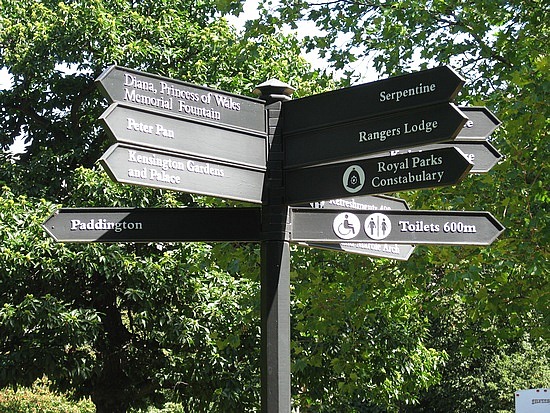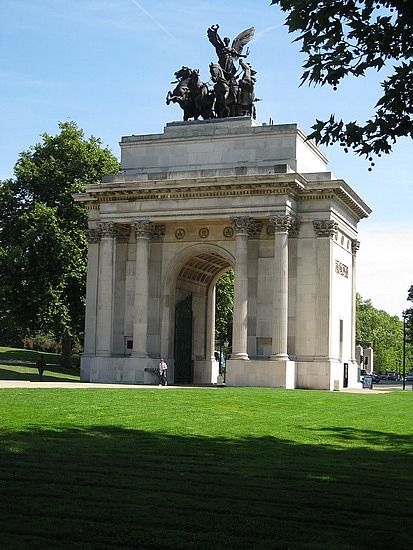Profile
Blog
Photos
Videos
Travel Blog of the Gaps
Language, particularly written language, uniquely sets human beings apart from our animal kin.
Birds, chimps, whales & elephants are known to communicate with their voices. But unlike them, we humans can receive communication from the dead ... provided that, before they died, they happened to jot their ideas down. Shakespeare, Newton, Tennyson, etc. immortalized themselves in this way, and we, their afterlings, have been learning from them ever since. For all this, we can thank written language.
But this is true only so long as someone is left alive who knows how to decipher the symbolic codes that we now call letters, numbers, and words.
Which brings me to my day in London. I mostly spent it cavorting about The British Museum. And there, in the Ancient Egypt exhibit hall, you can see the Rosetta Stone.
This fragment of rock, about a yard squared, was unearthed in 1799 when the Napoleon's forces occupied Egypt. Until then, it had for a couple of centuries been employed as a foundation stone. In other words, it was being used like we today use cinder blocks, aka, the Rodney Dangerfield of building materials.
The French officer in charge of a demolition project saw the carved lettering & symbols on it and, in the fashion of all great discoverer's said, "Hmm! That's funny!" Or since he was French, he probably grunted something like, "Sacre *****!"
The stone that he found is inscribed with a rather mundane set of civil decrees from about 200 years BCE (or BC, if you prefer). Yet in true bureaucratic fashion, the inscriptions are provided in triplicate, i.e., in three different languages: Ancient Greek (similar to the New Testament or Plato), Demotic (another dead but still understood Egyptian language), and Egyptian hieroglyphics.
By 1799, no one was left alive who understood Egyptian hieroglyphics. Not a single person. It was as if fate had pressed the mute button on the ancient Egyptians' attempts to communicate with future generations. But here was a stone that gave linguists access to direct translations of words, phases, and concepts in two well understood languages. With the Rosetta Stone as a key to the structure and vocabulary of Egyptian hieroglyphics, within 25 years, they had finally translated the writings on the walls of the Pyramids, the Valley of the Kings, all the archeological sites in Egypt.
The Rosetta Stone loosed the tongues of the ancient Egyptians, and they now can communicate with us, just as they intended.
And there the Stone sits in the British Museum. And that was very cool.
I've already loosed my own tongue to excess tonight, so tomorrow I'll fill you in further about the rest of the British Museum and my night taking in a play in London's West End. Until then, peace to you all.
Birds, chimps, whales & elephants are known to communicate with their voices. But unlike them, we humans can receive communication from the dead ... provided that, before they died, they happened to jot their ideas down. Shakespeare, Newton, Tennyson, etc. immortalized themselves in this way, and we, their afterlings, have been learning from them ever since. For all this, we can thank written language.
But this is true only so long as someone is left alive who knows how to decipher the symbolic codes that we now call letters, numbers, and words.
Which brings me to my day in London. I mostly spent it cavorting about The British Museum. And there, in the Ancient Egypt exhibit hall, you can see the Rosetta Stone.
This fragment of rock, about a yard squared, was unearthed in 1799 when the Napoleon's forces occupied Egypt. Until then, it had for a couple of centuries been employed as a foundation stone. In other words, it was being used like we today use cinder blocks, aka, the Rodney Dangerfield of building materials.
The French officer in charge of a demolition project saw the carved lettering & symbols on it and, in the fashion of all great discoverer's said, "Hmm! That's funny!" Or since he was French, he probably grunted something like, "Sacre *****!"
The stone that he found is inscribed with a rather mundane set of civil decrees from about 200 years BCE (or BC, if you prefer). Yet in true bureaucratic fashion, the inscriptions are provided in triplicate, i.e., in three different languages: Ancient Greek (similar to the New Testament or Plato), Demotic (another dead but still understood Egyptian language), and Egyptian hieroglyphics.
By 1799, no one was left alive who understood Egyptian hieroglyphics. Not a single person. It was as if fate had pressed the mute button on the ancient Egyptians' attempts to communicate with future generations. But here was a stone that gave linguists access to direct translations of words, phases, and concepts in two well understood languages. With the Rosetta Stone as a key to the structure and vocabulary of Egyptian hieroglyphics, within 25 years, they had finally translated the writings on the walls of the Pyramids, the Valley of the Kings, all the archeological sites in Egypt.
The Rosetta Stone loosed the tongues of the ancient Egyptians, and they now can communicate with us, just as they intended.
And there the Stone sits in the British Museum. And that was very cool.
I've already loosed my own tongue to excess tonight, so tomorrow I'll fill you in further about the rest of the British Museum and my night taking in a play in London's West End. Until then, peace to you all.
- comments










